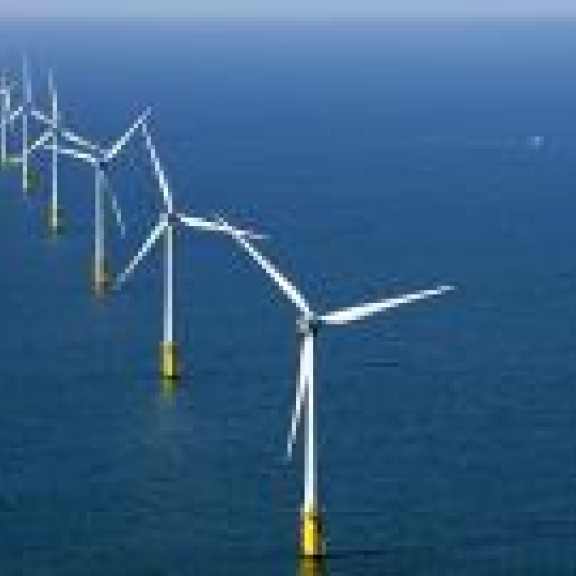
Cooperation is crucial to offshore wind farms
The Netherlands is about to witness the emergence of significantly larger offshore wind farms. In addition to resulting in estimated double revenues for the wind energy industry by 2030, this will lead to the creation of around 25,000 to 30,000 new jobs.
‘We have already started preparing for these changes. Flexibility, cooperation with other ports and knowledge creation are all crucial,’ says Femke Brenninkmeijer.
Brenninkmeijer, who heads up Port of Amsterdam’s Energy, Cargo & Offshore department, regards the development of new offshore wind farms as an excellent opportunity for AYOP to step up efforts to make the energy transition a reality. AYOP is an acronym for Amsterdam IJmuiden Offshore Ports, a partnership between the ports of Amsterdam, IJmuiden, Velsen and Zaanstad, which are located at an average distance of 20 miles from the wind farms earmarked for construction.
Operational base
Brenninkmeijer: ‘We benefit from an excellent operational base. The port of IJmuiden is located on the seaward side, which is used for the maintenance of the materials used – including turbines, nacelles and the massive blades. It is also home to the sea lock, whose size, depth and width are set to be extended in 2022 in order to accommodate the supply of the wind farms. In our own area behind the lock, we have designated a space of 35 hectares for offshore wind farms. Numerous companies located in our hinterland are, in fact, already involved in installing the facilities, providing power cables, and storing large parts for the turbines. These operations are very complementary to each other.’
Economies of scale
The partnership between the ports is essential, as wind farms are rapidly increasing their operational scale. Whereas two years ago turbines averaged a capacity of around six megawatt (MW), today we are seeing the construction of turbines with a power rating of more than 10 MW, including for the designated wind farm zone Hollandse Kust (with its southern and northern sites).
The southern site of the Hollandse Kust wind farm zone includes two 700 MW wind farms, while the northern site comprises one wind farm of this size. The wind farms at the northern site and the southern site are located just 22 miles and 18 nautical miles from IJmuiden, respectively. The construction of the southern site of the Hollandse Kust wind farm zone is scheduled to start in 2020, followed by the construction of the northern site in 2021.
Cooperation
Brenninkmeijer feels the rapid growth of the wind energy industry is a game changer for the area: ‘We have been working together for some time through the network hub for oil and gas, but if revenues from the new wind energy cluster were to increase tenfold, we’re going to need all our ports more than ever.’
As Brenninkmeijer explains, this will need to involve more than cooperation alone: ‘We will also need to ramp up efforts to generate new knowledge through educational institutions such as the University of Amsterdam, Techport and Nova College. The main challenge, in any case, will be hiring and training sufficient numbers of qualified technical staff for large-scale offshore wind farms. Marketing and Sales will also need to amp up their game by coming up with more competitive propositions if we want the new on-shore wind energy sites to really come into their own.’
Space
Increasing operational size in the wind energy industry does not only create a need for cooperation – flexibility is every bit as important.
The most recent tender, in mid-2018, even resulted in the construction of the world’s first-ever subsidy-free wind farm (Vattenfall off the southern site of the Hollandse Kust wind farm zone).
‘The fact that they’re under pressure to keep reducing costs calls not only for flexibility on the part of ports; they also need to have the space available to make it happen,’ Brenninkmeijer says.
‘That’s why we intend to build an energy hub right across from the sea port of IJmuiden. This is essential, because the increase in the operational size of wind farms will make it increasingly difficult to transport components by road.’
Hydrogen cluster
Port of Amsterdam is currently preparing the creation of a hydrogen cluster, as has been advocated for some time by numerous experts, including Delft University of Technology Professor Ad van Wijk. Hydrogen is the main link in the energy transition: as well as serving as a storage medium in the energy transition (through electrolysis), it can also be used as a viable substitute for natural gas.
‘In addition to developing plans for our port to become an energy hub, we are in the process of creating a hydrogen cluster,’ Brenninkmeijer says. ‘Once the Energy Agreement is signed, the Climate Tables want renewable energy sources to be the standard.
Hydrogen generated by wind energy is one option that has a lot of potential: in the built-up area, for synthetic kerosene and for steel production. We’re not sure at this point whether this hydrogen will be generated and/or stored on-shore or offshore, but it’s certain that we will be seeing a whole new calibre of players – including Tata Steel – get on board this go-around.’
New orders
Although the wind energy industry is largely project-driven and is currently anticipating a pork cycle, Brenninkmeijer believes all stakeholders need to start gearing up for a slew of new orders. ‘There is an immediate demand for 3,500 kilometres of cables, in addition to a need for a staggering 50,000 kilometres down the line. The shipbuilding industry will also have its work cut out for it, with a steady demand for repairs, alterations and new types of vessels.'
'We are planning a series of knowledge-sharing sessions to disseminate information and develop the flexibility needed to handle whatever the future might bring,’ Brenninkmeijer concludes.
Article by: Tseard Zoethout